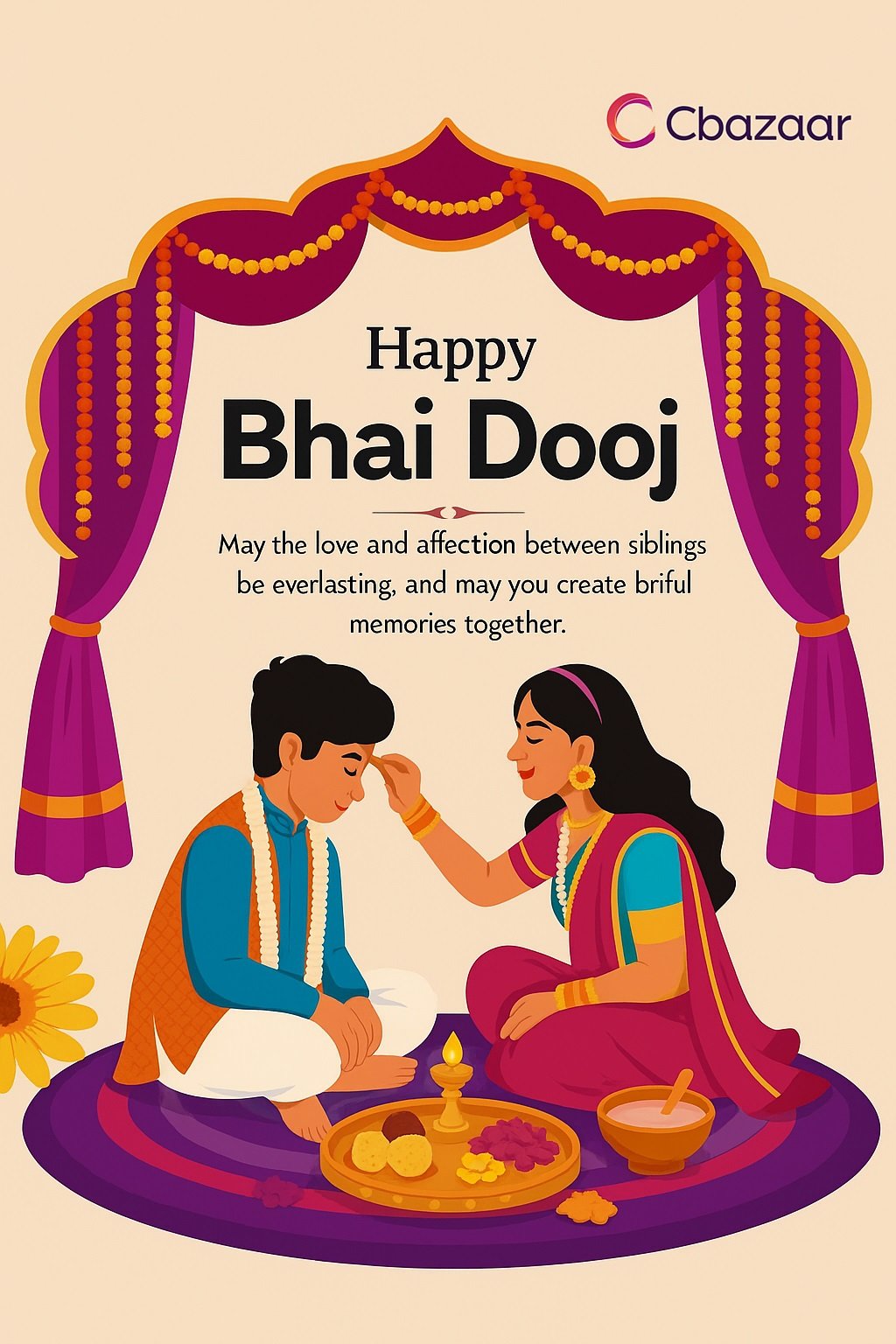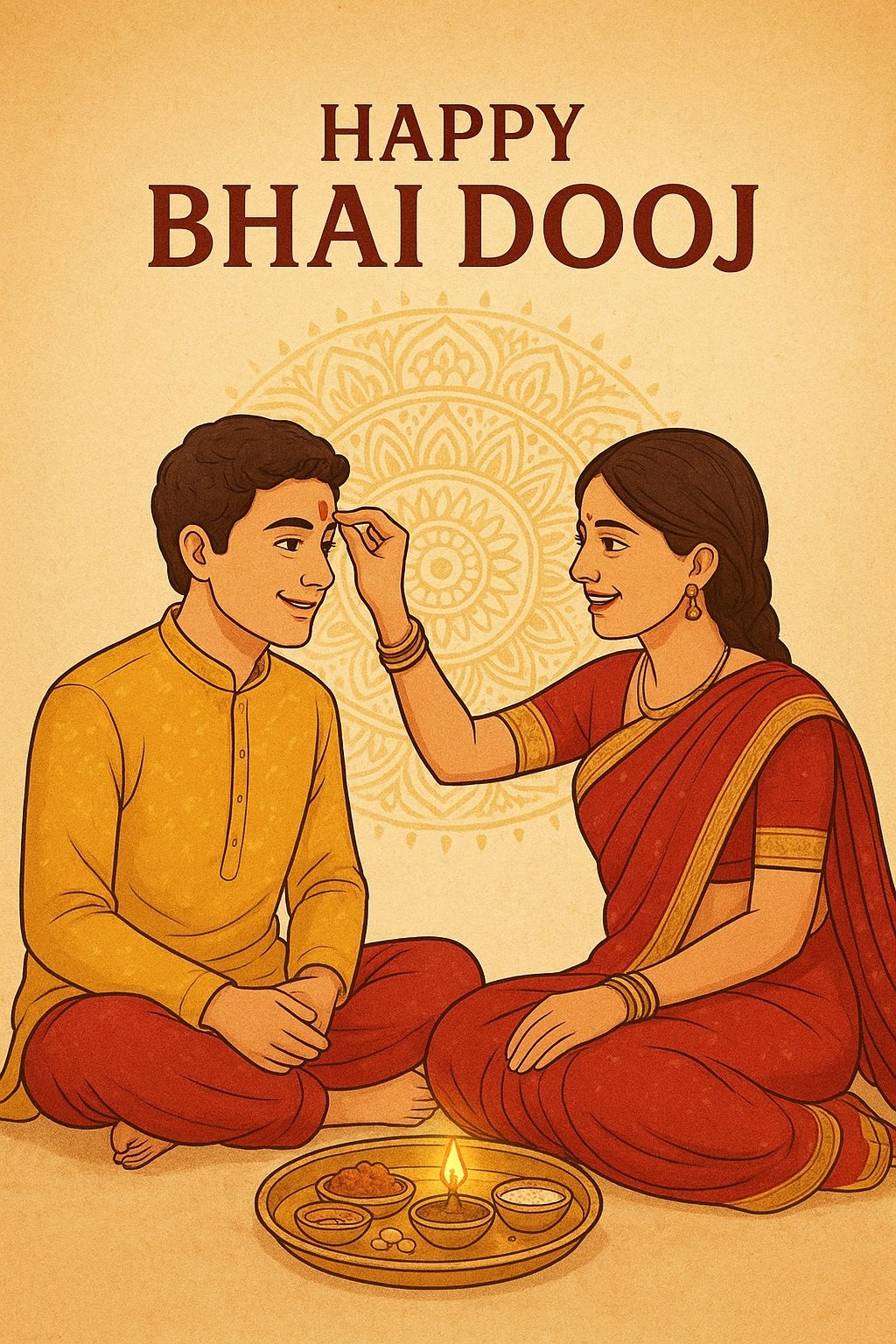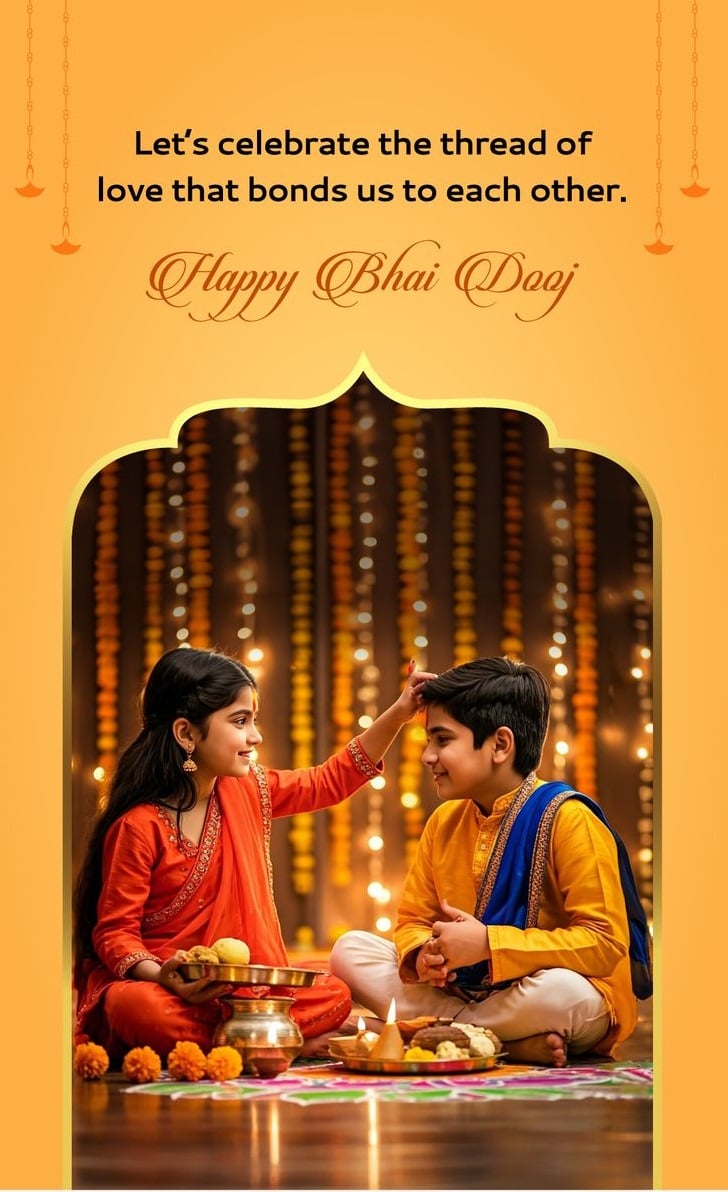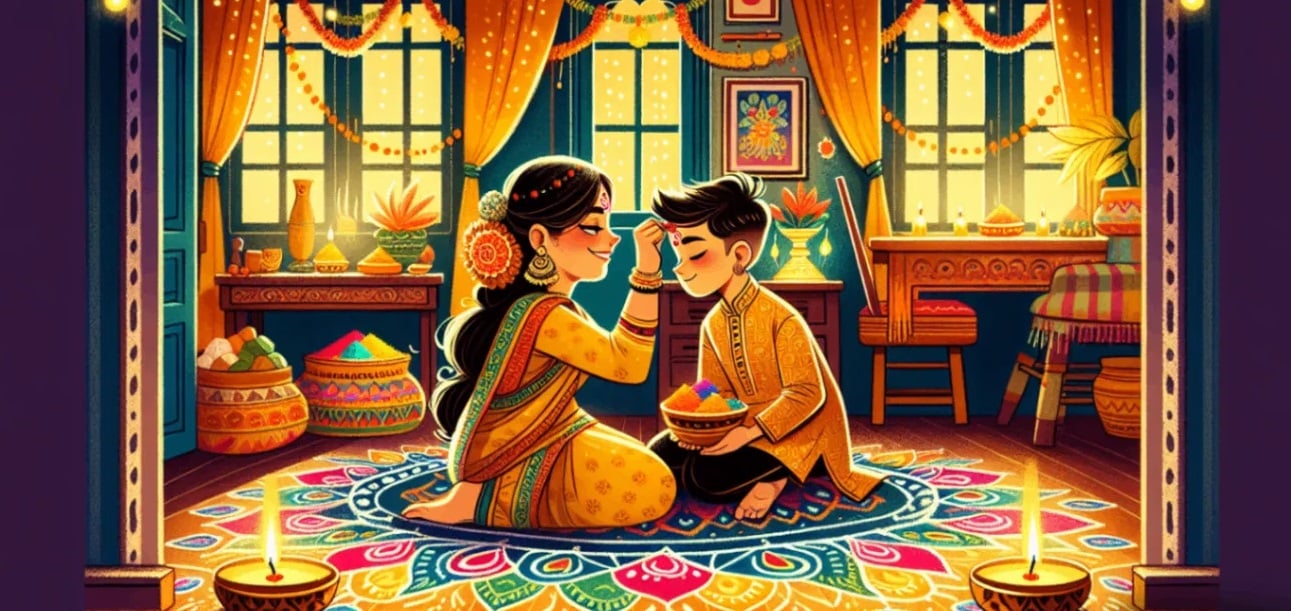How Bhai Dooj Is Celebrated Across India: Regional Traditions
India is a land of diverse traditions, colorful festivals, and deep-rooted cultural bonds. Among the many celebrations that honor the sacred ties of family, Bhai Dooj holds a special place. This festival celebrates the affectionate bond between brothers and sisters — a relationship built on love, protection, and mutual respect. While it shares its emotional essence with Raksha Bandhan, Bhai Dooj has its own unique rituals and stories. Interestingly, the way this festival is observed varies from region to region, reflecting India’s cultural diversity. Let’s explore how Bhai Dooj is celebrated across different parts of India and how each state adds its own distinctive flavor to this beautiful occasion.
The Essence and Legend of Bhai Dooj
Bhai Dooj, also known as Bhau Beej, Bhai Tika, or Bhai Phonta, falls on the second day (dooj) of the bright fortnight of the Hindu lunar month Kartika, just after Diwali. According to Hindu mythology, the festival is associated with Lord Krishna and his sister Subhadra. After Krishna defeated the demon Narakasura, Subhadra welcomed him home with sweets and flowers, applied a ceremonial tilak on his forehead, and prayed for his well-being. This symbolic act of love and care is what sisters across India replicate during Bhai Dooj.
 Another legend tells of Yamraj, the god of death, visiting his sister Yamuna on this day. She greeted him with an aarti, applied a tilak, and offered food. In return, Yamraj blessed her and declared that any brother who visits his sister on this day and receives her blessings will be freed from all sins and attain prosperity. Thus, Bhai Dooj is also known as Yama Dwitiya in some parts of India.
Another legend tells of Yamraj, the god of death, visiting his sister Yamuna on this day. She greeted him with an aarti, applied a tilak, and offered food. In return, Yamraj blessed her and declared that any brother who visits his sister on this day and receives her blessings will be freed from all sins and attain prosperity. Thus, Bhai Dooj is also known as Yama Dwitiya in some parts of India.
North India: Bhai Dooj – The Festival of Sibling Love
In North India, Bhai Dooj is celebrated with great enthusiasm, especially in states like Uttar Pradesh, Haryana, Punjab, and Delhi. Sisters invite their brothers to their homes, perform an aarti, and apply a red vermilion tilak on their foreheads while praying for their long life and happiness. In return, brothers give gifts, money, or sweets as a token of love.

picture courtesy : pinterest
A traditional delicacy of the day is puri, halwa, and kachori, along with favorite sweets like barfi and ladoos. Families gather for festive meals and exchange warm memories. In urban areas, even if brothers and sisters live far apart, they connect virtually or send gifts and sweets to maintain the festive spirit.
West Bengal: Bhai Phonta – A Sacred Ritual of Brotherhood
In West Bengal, the festival is known as Bhai Phonta, and it is celebrated with much pomp and devotion. Sisters observe a fast until they apply the phonta (tilak) on their brothers’ foreheads. The tilak is prepared using sandalwood paste, kajal, and ghee, and is applied with sacred mantras for their brothers’ prosperity and longevity.
picture courtesy : pinterest
A special ritual of lighting an oil lamp symbolizes the sister’s prayer for her brother’s long life. After the rituals, a grand feast follows, featuring authentic Bengali dishes such as luuchi, cholar dal, mishti doi, and various sweets like rosogolla and sandesh. The day is filled with laughter, blessings, and familial warmth.
Bhai Tika in Nepal and North-Eastern India
In Nepal, Bhai Dooj is celebrated as Bhai Tika and holds immense cultural and emotional significance. It is one of the most elaborate celebrations of the brother-sister relationship in the world. Sisters perform a detailed ritual where they apply a seven-colored tika on their brothers’ foreheads — each color representing a different blessing, such as prosperity, strength, and long life. They also circle their brothers with holy water and light, symbolically driving away evil spirits.
picture courtesy : pinterest
Brothers, in return, offer their sisters gifts and promise eternal protection. The festival is celebrated with festive foods like sel roti, yomari, and various sweets. It is common to see families come together in traditional attire, making the day vibrant and full of joy. In the Indian states bordering Nepal — such as Sikkim, Darjeeling and parts of Assam — similar customs are followed, reflecting a shared cultural heritage.
Maharashtra and Goa: Bhau Beej – A Day of Affection
In Maharashtra and Goa, Bhai Dooj is known as Bhau Beej. Sisters perform the aarti, apply tilak, and offer dry coconut and sweets to their brothers. A traditional Maharashtrian dish, basundi poori, is commonly prepared on this occasion.
In Konkani-speaking regions, the festival is also called Bhau Bij. Brothers visit their sisters’ homes, and the atmosphere is filled with festive cheer and traditional songs. In some communities, sisters who do not have brothers worship the moon as a symbolic brother and seek blessings for a prosperous life — a beautiful reminder of the inclusive nature of Indian traditions.
Gujarat: Bhai Beej – A Festival of Gratitude
In Gujarat, the festival is also called Bhai Beej or Bhai Bij, and it follows similar rituals to those in Maharashtra. Sisters invite their brothers for a lavish meal, and the celebration usually takes place after the grand Diwali festivities. Brothers give gifts to their sisters as a sign of affection and gratitude.![ભાઈ બીજ ની શુભેચ્છાઓ, શાયરી અને સુવિચાર [2025] - SaralGujarati.in](https://blogger.googleusercontent.com/img/b/R29vZ2xl/AVvXsEjiupwfi-yjKf1Uhl-5C_y1KLLz795-a6BM2OhAqpGnDffWuiZDBFCY4EOR3QUbx26ZNs80srcN3zyN6YHS4SVG3VZY6YKsVCoIameN6Kn-zXdckeU8xeFQV6IEWKimmNyiYa0_XxsK88QIfnTnVpOm22SfYc79r-EJ_eN0zuhMCteK0DhXL9YI4U5-jWo/s1280/%E0%AA%AD%E0%AA%BE%E0%AA%88%20%E0%AA%AC%E0%AB%80%E0%AA%9C%20%E0%AA%B6%E0%AB%81%E0%AA%AD%E0%AB%87%E0%AA%9A%E0%AB%8D%E0%AA%9B%E0%AA%BE%E0%AA%93%202.webp)
picture courtesy : pinterest
Gujarati families often prepare traditional sweets such as ghughra, shakarpara, and sev, while elders bless the younger ones. The day marks not just a family bond but also the end of the festive season, making it an occasion of both joy and emotional reflection.
Bihar and Jharkhand: Yama Dwitiya – The Mythological Connection
In Bihar and Jharkhand, Bhai Dooj is often called Yama Dwitiya, based on the legend of Yamraj (the God of Death) and his sister Yamuna. According to mythology, Yamraj visited his sister Yamuna on this day, and she welcomed him with great respect, applied a tilak, and offered sweets. Pleased with her affection, Yamraj declared that any brother who receives a tilak from his sister on this day would never fear untimely death.
picture courtesy : pinterest
In many homes in Bihar, sisters invite their brothers for a meal and perform a symbolic ritual with betel leaves, betel nuts, and rice, signifying prosperity. The festival emphasizes the spiritual protection a sister’s love can provide.
Bhai Dooj in South India
While Bhai Dooj is more prominent in North India, some South Indian states have similar celebrations under different names. In Karnataka and Andhra Pradesh, the festival is called Yama Dwitiya, and it marks the sacred meeting of Yamraj and Yamuna. Sisters perform the aarti and apply tilak to their brothers, followed by a shared meal. In Tamil Nadu, it is observed by a few families as part of post-Diwali traditions, emphasizing the universal value of sibling love.
picture courtesy : pinterest
The Modern Touch
In today’s fast-paced world, Bhai Dooj continues to evolve. With many siblings living in different cities or countries, digital celebrations have become common. Sisters send virtual tilaks, e-gifts, or online sweets, while brothers respond with heartfelt video calls and surprise gifts. Despite the changing times, the emotional essence of the festival remains unshaken — it’s a day to express gratitude, affection, and the eternal promise of care.
A Celebration That Unites Hearts
No matter what it’s called—Bhai Dooj, Bhau Beej, Bhai Phonta, or Bhai Tika—the spirit of the festival remains the same. It’s a day when siblings set aside everything else to express their love and gratitude for each other.
From the sacred tilak ceremony to the joy of dressing up in festive finery and sharing home-cooked meals, Bhai Dooj brings families closer, reinforcing the importance of relationships in Indian culture.
picture courtesy : pinterest
So this Bhai Dooj, whether you’re in Mumbai, Kolkata, or anywhere across the world, take a cue from these beautiful regional traditions. Celebrate your sibling bond with love, laughter, and a touch of tradition—and if you’re looking for the perfect outfit to make the day even more memorable, Cbazaar’s exquisite festive collection is the ideal way to do it in true Indian style.




Leave a Reply